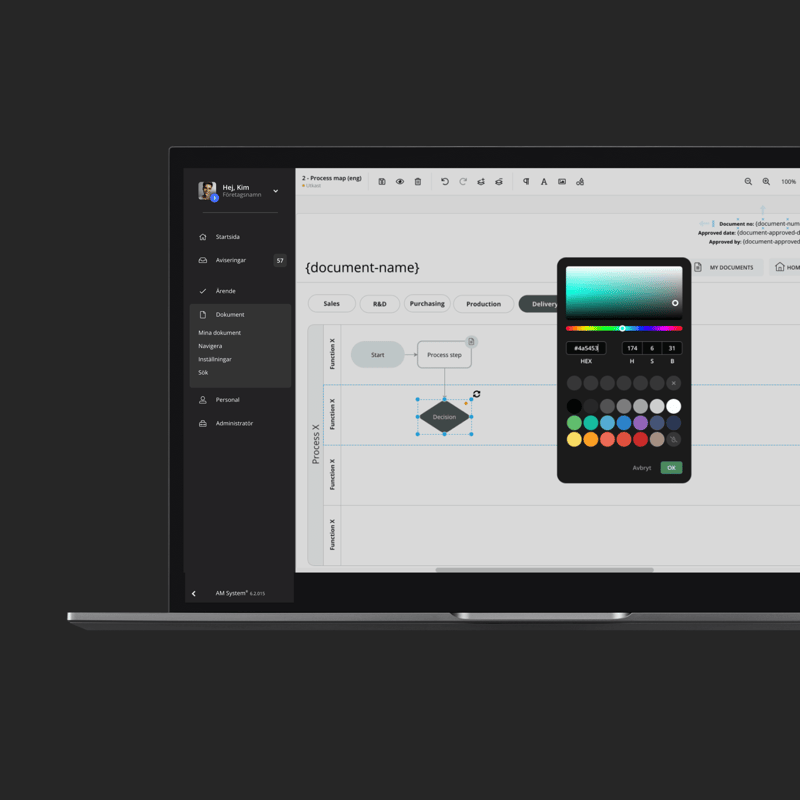Article
From process maps to system thinking: A new perspective on the whole organization
-
 Editorial team
Editorial team
-
- Process Mapping
- 4 min reading

Many organizations strive to improve their work practices and increase their productivity through tools such as process maps and flowcharts. These methods are valuable for visualizing and optimizing workflows, but they have their limitations.
To gain a deeper understanding and make long-term improvements, a broader perspective is needed - this is where systems thinking comes in.
Systems thinking offers a holistic view of the organization by analysing how different parts interact, which resources affect performance, and how changes in one part of the organization can have an impact on others. It is a powerful tool for creating sustainable improvements and optimizing the whole system instead of individual parts.
What is systems thinking?
Systems thinking means seeing the organization as a complex network of resources, flows and relationships that together create value. Unlike traditional process maps, which focus on sequential steps in a work process, systems thinking helps you understand how different parts of the organization affect each other over time.
A system consists of three basic components:
- Things: the elements that make up the system, such as people, technology or capital.
- Linkages: The processes and relationships that connect the things, such as workflows, information exchange or financial transactions.
- Purpose or function: The overall goal of the system, which often emerges through observation rather than explicitly stated objectives.
For example, an organization can be considered as a system where the people, tools and resources are the things; the work processes and communication pathways are the links; and the purpose is to deliver value to customers.
Systems thinking vs traditional methods
Activity focus: Efficiency in daily work
When organizations work at the activity level, it is about optimizing individual tasks and steps. This may mean improving the performance of a machine, training staff or introducing new tools that streamline workflow. Activity focus can be effective for short-term gains but risks missing the impact of changes on other parts of the organization.
Process focus: Improving workflows
Process focus means that the organization views workflows from a holistic perspective and maps how different steps are connected. Process maps and flowcharts are common tools here. By visualizing the processes, the organization can identify bottlenecks and inefficiencies. Process focus provides a better holistic view than activity focus but often lacks insight into
how processes affect other parts of the system over time.
Systems thinking: understanding the big picture and creating long-term solutions
Systems thinking goes beyond process maps by analysing how resources and flows interact and affect the overall purpose of the organization. It allows you to identify root causes of problems, anticipate unintended consequences of change and create strategies that improve the whole organization. Systems thinking takes into account the dynamics of the organization and helps you balance short-term actions with long-term goals.
Resources and flows: the basis of systems thinking
In systems thinking, resources and flows are the fundamental building blocks.
- Resources are the things that the organization manages and uses to create value. They can be staff, customer satisfaction, capital, inventory or technology.
- Flows are the processes that replenish or deplete resources over time. Inflows could be, for example, new recruitment or sales, while outflows could be staff turnover or customer losses.
Think of a resource as "competent staff." Inflows could be recruitment and internal training, while outflows could be staff turnover or retirement. Analyzing both inflows and outflows will help you understand how resource levels change and what you can do to influence them.
How to start with systems thinking: A simple systems map
Step 1: Identify the resources
Start by listing the most important resources in your organization. These could be
- Staff.
- Customer satisfaction.
- Capital.
- Brand awareness.
Step 2: Map the flows
Analyze the inflows and outflows that affect resources. For 'competent staff', inflows can be new recruitment and further training, while outflows can be staff turnover or sick leave.
Step 3: Analyze the links
Look at how resources and flows affect each other. For example, if staff skills are affected by training, how does this in turn affect customer satisfaction and company sales?
Practical examples of systems thinking
Example 1: Competent staff
A company notices that they have difficulties retaining staff. By analyzing the system, they see that the outflows (turnover) are due to lack of development opportunities and higher salaries of competing employers. Instead of focusing solely on recruitment, they choose to strengthen inflows by improving training opportunities and creating a clearer career path.
Example 2: Customer satisfaction
An organization discovers that customer satisfaction is dropping. By analyzing the system, they realize that an increasing workload on support staff leads to longer response times. To improve customer satisfaction, they invest in both hiring more support staff (inflow) and streamlining workflows to reduce the outflow of dissatisfied customers.
The benefits of systems thinking
Using systems thinking as a tool in your organization means taking a step back and seeing the bigger picture. This mindset provides several tangible benefits that not only improve processes, but also strengthen the organization's long-term ability to manage change and challenges.
Holistic view: understanding how everything is connected
Systems thinking gives you a bird's eye view of the organization, allowing you to see how different parts interact and influence each other. Instead of just analysing a single process or function, you see the organization as a network of resources and connections.
For example, a change in the production process can affect not only production costs but also customer satisfaction, the supply chain and employee workload. By understanding how these parts are interlinked, you can make decisions that improve the whole instead of creating imbalances.
Long-term solutions: Go to the root causes
One of the greatest strengths of systems thinking is its focus on identifying and addressing root causes rather than symptoms. This means you can create actions that truly solve the problem instead of just dealing with its consequences.
For example, if your organization is experiencing high staff turnover, a systems thinking approach may reveal that the cause is not just about salaries, but about a lack of career opportunities or an unbalanced workload. By addressing these root causes, you can reduce turnover in a sustainable way.
Anticipate consequences: avoid new problems
When you view your organization as a system, you can analyze how changes in one part of the system affect other parts. This allows you to anticipate and avoid unwanted consequences that may arise from improvement initiatives.
Example: If you decide to increase production speed, it may negatively affect quality control, which in turn leads to more defects and complaints. Systems thinking allows you to identify and manage such links before implementing the change, ensuring that the improvement does not create new problems.
Efficient use of resources: maximize the value of your efforts
Systems thinking helps you analyse the inflows and outflows of your organization, allowing you to prioritize efforts that have the greatest impact on resources. Instead of focusing solely on increasing inflows, such as recruiting more employees or selling more products, you can also identify ways to reduce outflows - for example, by improving employee satisfaction or reducing production waste.
By using resources more efficiently, you can improve your organization's productivity and profitability without having to increase costs or workload. This results in a more balanced and sustainable development over time.
Conclusion: From process maps to systems thinking
Moving from process maps to systems thinking means taking a step back and seeing the big picture. With systems thinking, you can not only optimize individual parts of the organization, but also understand and improve the interactions between them. It is a powerful tool for creating an organization that is not only fit for today's challenges, but also for the future.
If you want to delve deeper into systems thinking, we recommend the book Thinking in Systems: A Primer by Donella H. Meadows - an excellent resource to learn more about this way of thinking.
Get a demo
Ready to make work easier - and more enjoyable?
Want to see for yourself how AM System can make a difference for you? Book a demo and discover how easy it is to create structure, efficiency, and seamless workflows in your daily operations.
